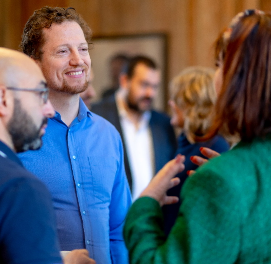If you want to be a leader who has space to be creative, you need to know your team has the commitment to take ownership and move forward with autonomy.
Charles Brook, Founder and Managing Partner at TPC Leadership, explains that tackling the issue of buy-in among teams helps release their full potential: “Investing time upfront to get buy-in, commitment and accountability pays dividends downstream.”
“It is the job of the team leader to get the best out of their people,” adds Peter Wall, TPC Leadership Associate. “My experience of leading teams is that the more you can let go of the micro-detail, the more people will become creative and able to problem-solve independently.”
How do you know if you have buy-in?
“I have a few litmus tests,” says Peter. “The simplest is to look at what happens when the team leader is unavailable for a team meeting. If the team cancels it, it’s a tell-tale sign that they don’t have the commitment to be accountable.”
Peter’s second test is the degree to which people are willing to disagree publicly in a constructive way. “Harmonious interactions can often be a mask for the real conversation,” he explains. “It’s tempting to diffuse tension, but this can be counterproductive. To get genuine alignment you must recognise that it’s normal for people to disagree sometimes and okay to have those conversations.”
One way to assess the level of alignment in a virtual meeting setting is to invite people to use icons to illustrate their position. “It’s better to know if people aren’t going to buy in,” says Charles. “Identifying and discussing obstacles to buy-in allows for feedback and creativity.”
Establish operating principles
Tense situations can be difficult to navigate, so have an approved process for what happens if team members don’t all agree. This may be as straightforward as a vote, or as Peter suggests, asking, “If you don’t agree, can you live with it?” and if not, “What would it take to be able to live with it?” This approach won’t always result in agreement, but it allows for all parties to be heard, and that helps with buy-in.
Ensure you have a robust action log in place. This should detail exactly what has been agreed, who is responsible for doing it, the timeframe and what the end product should look like. “Freeing time for review and agreeing a roadmap for moving forward,” says Charles, “will also help build ownership and accountability.”
Keep constructive conversations inside the meeting
Successful teams have dynamic, open discussion within their meetings. In teams that don’t work so well, conversation may spill outside the meeting space and become counterproductive.
“Keeping conversations constructive and inside the meeting should be one of your operating principles,” says Peter. To do that, you need to establish trust and build connections, because that’s when honest conversations happen. “Move away from the intimidating notion of conflict and re-phrase the message to emphasise that it’s ok to disagree and explore other ideas, explains Peter. “It’s the job of the team leader to model that.”
Looking to get the best out of your teams? Get in touch with us to find out how we can help.
If you’d like to sign-up for our free virtual teams training modules you can register here.





